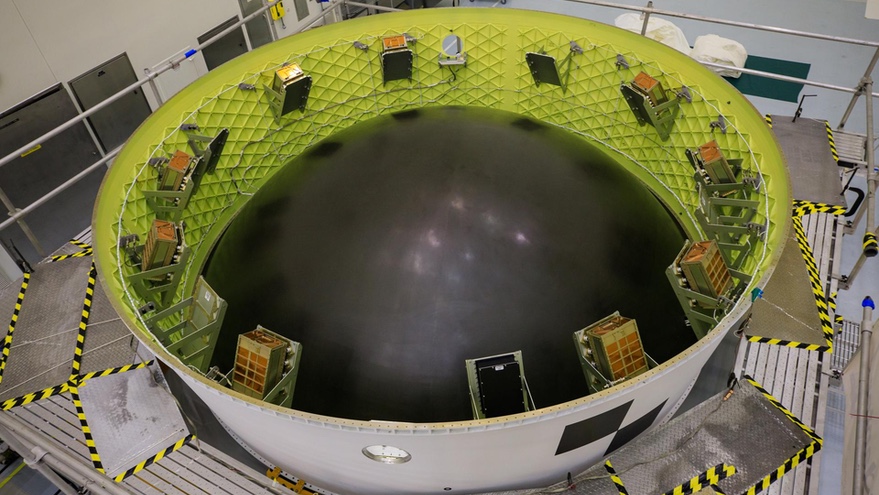WASHINGTON — The first flight of the Space Launch System will carry along with the Orion spacecraft 10 cubesats intended to carry out missions from prospecting for lunar ice to flying by an asteroid — if they’re not dead on arrival.
Preparations continue for an Aug. 29 launch of the Artemis 1 mission, with NASA reporting no issues with the SLS or Orion spacecraft. A weather forecast from Space Launch Delta 45 Aug. 25 projected a 70% chance of acceptable weather for the launch during a two-hour window that opens at 8:33 a.m. Eastern.
The primary purpose of the launch is to fly the Orion spacecraft around the moon, testing its capabilities before reentering and splashing down off the California coast about six weeks after liftoff. A successful flight would allow NASA to proceed with the first crewed Orion mission, Artemis 2, as soon as late 2024.
In addition to Orion, though, SLS is carrying 10 6U cubesats in an adapter ring that connects Orion to the SLS upper stage. Those cubesats will be deployed from the upper stage at three “bus stops” on the way to the moon after Orion separates.
The cubesats are from a variety of organizations in the United States as well as the Italian space agency ASI and Japanese space agency JAXA. Four of them are devoted to studies of the moon, including JAXA’s OMOTENASHI, which will attempt a “semi-hard” landing on the moon that would make it the world’s smallest lunar lander.
Three others will study space weather and the radiation environment in cislunar space, such as the effects of that radiation on living organisms. Two cubesats will conduct technology demonstrations of deep-space communications, plasma thrusters and advanced optics. NASA’s NEA Scout will attempt to deploy a solar sail that will allow it to fly by a small near Earth asteroid.
“Cubesats are a lower-cost approach to capturing scientific measurements that are high risk but also high reward,” said Jacob Bleacher, chief exploration scientist at NASA, during an Aug. 15 briefing about several of the cubesats.
For some of the cubesats, the risks could be realized as soon as they are deployed. NASA required the spacecraft to be delivered a year ago so they could be installed on the adapter before Orion was integrated. Once Orion was in place, there was no way to access the cubesats.
While some of the cubesats have access to power to keep their batteries charged, five of them — CuSP, LunaH-Map, Lunar IceCube, LunIR and Team Miles — did not. Their batteries have been slowly discharging since they were installed in the payload adapter, raising concerns they may be too depleted to activate the satellites after deployment.
Craig Hardgrove, principal investigator for LunaH-Map at Arizona State University, said at the Aug. 15 briefing that the SLS program “didn’t feel comfortable with us charging” and thus could not keep its batteries charged during the extended wait for the launch.
“It is a concern,” he said, but was optimistic that, given measured rates of discharge, the battery level should be sufficient for a launch during the current opportunity that runs through early September. If not, there are two solar panels that will be exposed immediately after deployment that should generate enough power to recharge the batteries. “For LunaH-Map, I think we should be OK with the launch coming up.”
While NASA said Team Miles was another cubesat not able to charge its batteries, Wesley Faler, head of the project that produced the technology demonstration cubesat, said the team decided not to charge. “We had the opportunity to charge but we opted out of it,” he said at an Aug. 16 briefing. “There’s such a low self-discharge rate on our batteries that we figured, why rock the boat and introduce the variable of recharging?”
The inability to charge, though, was a concern for some of the cubesats and was an issue they had been aware of for months as the Artemis 1 launch slipped to late summer. Some had quietly lobbied NASA for an opportunity to service the cubesats, which would have required removing Orion to gain access to the payload adapter.
“We’re trying to work through preparations and get the SLS ready to fly. That’s the best thing we can do at this point,” Bleacher said of the cubesats. “If we can get the SLS off at the end of this month or early September, we hope that they’ll all have the opportunity to be able to fly.”
Mike Sarafin, Artemis mission manager, offered a similar message Aug. 22 at a briefing after the Artemis 1 flight readiness review. “The cubesats are relatively low cost and have relatively low levels of redundancy,” he said. “We do anticipate one or more of these cubesats to not be successful in its mission just due to the nature of the cubesats themselves.”
Some cubesats failed to make it for the launch itself. NASA originally planned to fly 13 cubesats on Artemis 1, but three — Cislunar Explorers, CU-3E and Lunar Flashlight — were not ready before the deadline last fall for integration onto the SLS. The NASA-funded Lunar Flashlight, which suffered issues with its propulsion system, will instead fly as a secondary payload on the launch the IM-1 lunar lander mission by Intuitive Machines in early 2023.
In a presentation at the Small Satellite Conference at Utah State University Aug. 6, Brody Wallace of the University of Colorado said the CU-3E mission ran into several challenges, including dealing with safety requirements for flying on SLS. “The safety requirements for a human-rated launch vehicle are much larger than academic organizations are prepared for and anticipated,” he said.
Delays in the SLS launch also made it difficult to manage the project, which largely involved students, and there were funding issues as well. “The academic environment can handle technology challenges,” he said, “but are less prepared on the programmatic side.”
